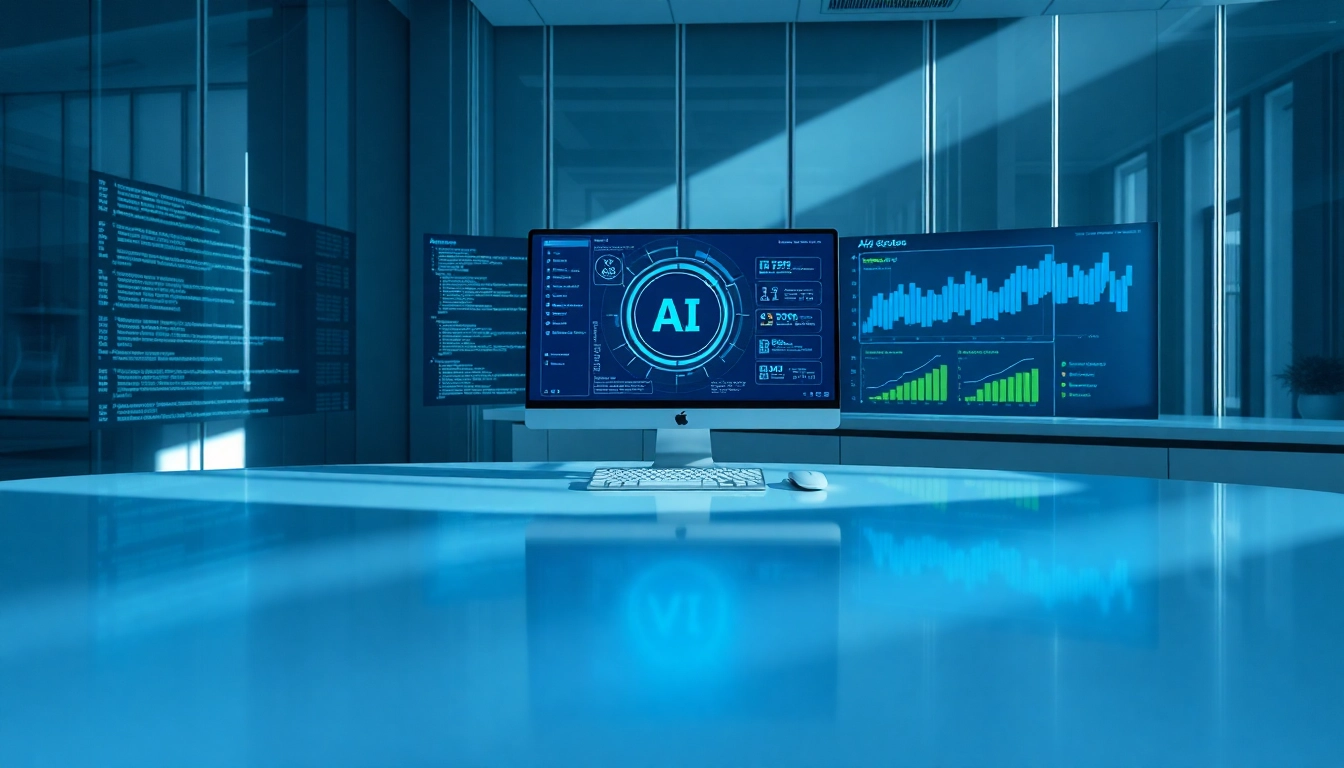
Introduction to ai detection
The world is increasingly being shaped by advancements in artificial intelligence (AI), leading to applications that are transforming various sectors, from education to content creation. However, as AI capabilities evolve, so do concerns regarding authenticity and the implications of AI-generated content. This is where ai detection comes into play, enabling us to differentiate between human and machine-generated outputs.
What is ai detection?
AI detection refers to the methodologies, tools, and technologies employed to identify content produced by AI models. These processes analyze text, images, and other forms of media to establish whether they originated from human creators or AI algorithms. Depending on the context and criticality of usage, the implications of misidentifying the source can vary significantly, highlighting the need for reliable detection mechanisms.
Importance of ai detection in various fields
AI detection plays a pivotal role across several domains:
- Education: With the rise of generative AI in writing, educators are increasingly concerned about the authenticity of student work. AI detection tools help uphold academic integrity by discerning AI-generated essays or homework.
- Marketing: In content creation, businesses must be able to verify that their marketing materials engage real human thoughts and narratives, preserving brand authenticity and integrity.
- Content Moderation: Social media platforms use AI detection to combat misinformation and deepfakes, ensuring the integrity of information shared on their sites.
- Legal Fields: Understanding whether a document is AI-generated is crucial for maintaining legal standards and intellectual property rights.
Challenges faced in ai detection
Despite its importance, the domain of AI detection is fraught with challenges:
- Rapid Technological Evolution: As AI models improve, the algorithms used for detection struggle to keep pace, often making the detection tools obsolete within a short timeframe.
- False Positives/Negatives: High rates of inaccuracy can lead to unfair consequences, such as labeling genuine human writing as AI-generated or vice versa.
- Lack of Standardization: With numerous detection tools available, the absence of a universal standard complicates the evaluation of their effectiveness.
How ai detection works
Understanding the workings of AI detection offers insights into its efficiency and limitations. The detection process typically follows a systematic approach involving various methodologies and technologies.
Key methodologies used in ai detection
Several methodologies exist in the realm of AI detection, each with its unique focus:
- Statistical Analysis: Detects patterns based on linguistic cues and structural elements commonly found in AI-generated content.
- Machine Learning: Trains models on known datasets of AI and human-generated text to improve detection accuracy.
- Natural Language Processing (NLP): Analyzes the syntax and semantics of text to understand the context and identify anomalies characteristic of AI-generated prose.
Technology behind detection algorithms
AI detection algorithms leverage various technologies, including:
- Deep Learning: Employs neural networks that mimic human cognitive processes, improving the detection of subtle patterns indicative of AI text generation.
- Data Mining: Extracts relevant features from large datasets to help capture AI-specific traits, leading to better classification outcomes.
- Sentiment Analysis: Gauges the emotional tone of the content, which can differ between human and AI text, providing further context for detection.
Recognizing AI-generated patterns
AI-generated content often exhibits certain identifiable traits, such as:
- Repetitive Structure: AI may produce content with a rigid structure or repetition due to algorithmic guidelines.
- Overly Formal Tone: Many AI models default to a formal tone that can feel stiff or unnatural.
- Vocabulary and Phrasing: AI often employs a set vocabulary, leading to a lack of diversity in word choice and phrasing.
Tools for effective ai detection
Incorporating detection tools into various workflows enhances the capacity to identify AI-generated content effectively. A multitude of tools available can aid in this mission.
Popular software and platforms for ai detection
There’s a wide range of software and platforms designed for AI detection, each equipped with its unique features. Some popular options include:
- AI content detectors that analyze textual submissions to assess their likelihood of being AI-generated.
- Plagiarism checkers that also incorporate AI detection functionalities, delivering a comprehensive analysis of originality.
- Standalone software offering AI detection specifically, allowing for a more focused approach while ensuring content integrity.
Comparison of accuracy among various tools
When considering detection tools, accuracy stands out as the most crucial factor. The effectiveness of various software can be gauged by:
- Direct testing against known datasets of AI and human content to measure detection rates.
- Feedback from users in real-world applications to evaluate performance metrics and user experiences.
- Longitudinal studies assessing the accuracy of each tool over time, factoring in the evolution of AI models.
Integrating detection tools in workflows
To maximize the effectiveness of AI detection, integrating tools seamlessly into existing workflows is essential. Best practices for integration include:
- Training Staff: Ensure users understand how to navigate the tools and interpret their results accurately.
- Establishing Protocols: Create guidelines for utilizing these tools, detailing when and how to apply them during the content creation and review processes.
- Regular Updates: Keep software and methodologies up-to-date to match the evolving landscape of AI capabilities.
Best practices for ai detection
Standardizing techniques and practices can greatly influence the effectiveness of AI detection. Below are some of the best practices to consider.
Preparing data for analysis
For effective analysis, it’s essential to prepare data adequately:
- Data Cleanliness: Ensure that the input data is free from errors and inconsistencies.
- Relevance: Select data that directly represents the types of content being generated, enhancing the detector’s ability to generalize from the sample.
- Diversity: Utilize a diverse range of examples in training datasets to improve detection accuracy across various AI models.
Interpreting ai detection results
Understanding the outputs of detection tools is vital for their effective use:
- Analytical Approach: Dig deeper into the results rather than taking them at face value, examining the underlying reasons for why content was flagged.
- Comprehensive Review: Consider the context of the content, as this can significantly influence detection outcomes.
- Feedback Loops: Create a system where users can provide feedback on detection results, fostering continuous improvement of the detection process.
Continuous improvement in detection techniques
The rapid evolution of AI necessitates ongoing improvement in detection methodologies:
- Research and Development: Invest continuously in R&D to stay ahead of emerging AI trends and detection challenges.
- Collaboration: Collaborate with experts and institutions focused on AI research and detection, enriching the knowledge pool.
- User Engagement: Gather insights from end-users about their experiences, leading to refinements in detection tools and methodologies.
The future of ai detection
The landscape of AI detection is poised to change as technology evolves. Understanding emerging trends and future considerations is crucial for maintaining effective detection practices.
Emerging trends in ai detection technologies
The future of AI detection will likely see:
- AI-Powered Detection: Future detection systems may themselves leverage AI to improve detection rates through adaptive learning.
- Integration with Other Technologies: Detection tools will likely integrate with blockchain and other verification technologies to ensure the authenticity of content.
- Standardized Frameworks: The establishment of universal guidelines for AI detection can enhance the overall effectiveness and reliability of these tools.
Ethical considerations in ai detection
As with any technology, ethical concerns in AI detection cannot be overlooked:
- Transparency: Users have a right to understand how detection algorithms function and the dataset they are based on.
- Privacy: Maintaining the confidentiality of users and the content they create is essential to respect their rights and foster trust.
- Bias Mitigation: Continuous efforts must be made to recognize and minimize bias in detection algorithms to prevent unfair consequences.
The role of ai detection in education
AI detection plays a transformative role in educational contexts:
- Supporting Academic Integrity: By verifying authenticity, AI detection tools help promote honesty in academic work.
- Enhancing Learning Opportunities: Educators can use detection tools to better understand student engagement and the effectiveness of instructional methods.
- Guiding Policy Development: Insights from detection results can inform policy decisions around AI use in educational settings.






